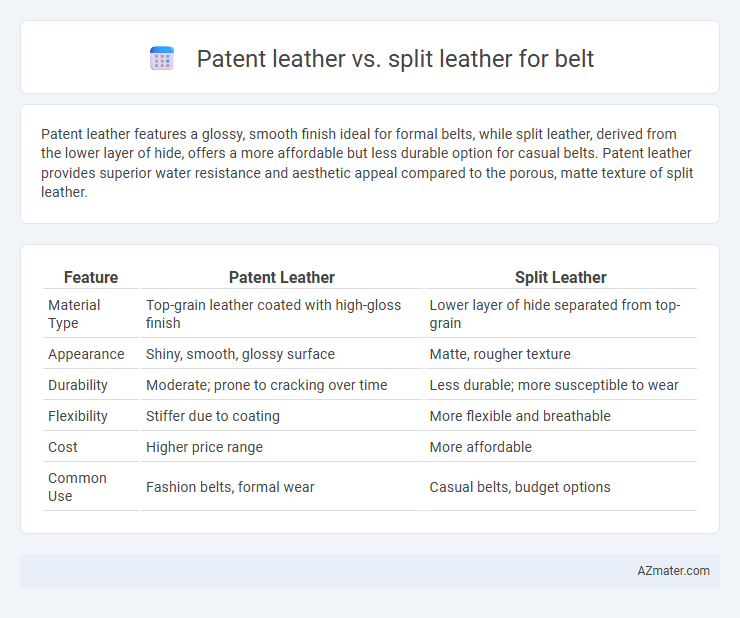Patent leather features a glossy, smooth finish ideal for formal belts, while split leather, derived from the lower layer of hide, offers a more affordable but less durable option for casual belts. Patent leather provides superior water resistance and aesthetic appeal compared to the porous, matte texture of split leather.
Table of Comparison
| Feature | Patent Leather | Split Leather |
|---|---|---|
| Material Type | Top-grain leather coated with high-gloss finish | Lower layer of hide separated from top-grain |
| Appearance | Shiny, smooth, glossy surface | Matte, rougher texture |
| Durability | Moderate; prone to cracking over time | Less durable; more susceptible to wear |
| Flexibility | Stiffer due to coating | More flexible and breathable |
| Cost | Higher price range | More affordable |
| Common Use | Fashion belts, formal wear | Casual belts, budget options |
Introduction to Patent Leather and Split Leather
Patent leather features a high-gloss, mirror-like finish achieved through a coating process that enhances durability and water resistance, making it a popular choice for formal belts. Split leather, derived from the fibrous lower layers of a hide, is more porous and less durable, often used for cost-effective belts with a softer texture. The fundamental difference lies in production and finish, with patent leather offering superior shine and longevity compared to the matte, flexible nature of split leather.
Defining Patent Leather: Key Features
Patent leather is a type of coated leather known for its glossy, high-shine finish achieved through a layer of lacquer or synthetic polymer. This smooth, reflective surface provides excellent water resistance and a polished aesthetic ideal for formal belts. In contrast, split leather is derived from the lower layers of the hide and lacks the durable top grain, resulting in a matte texture that is less resistant to moisture and wear.
What is Split Leather? Essential Characteristics
Split leather is derived from the fibrous lower layers of a hide after the top grain layer is separated, offering a rougher and more porous texture compared to patent leather. Essential characteristics of split leather include its softness, flexibility, and susceptibility to staining or damage due to its open pores without a protective topcoat. Unlike the glossy, coated finish of patent leather, split leather often requires additional treatments or coatings to enhance durability and appearance in belt applications.
Durability Comparison: Patent vs Split Leather Belts
Patent leather belts feature a glossy, coated surface that offers water resistance and easy cleaning, enhancing their durability against stains and moisture. Split leather belts, made from the fibrous lower layers of hide, tend to be less durable, as they lack the dense grain structure of full-grain or patent leather and may wear out or crack more quickly under regular use. When choosing for long-lasting belt performance, patent leather provides superior resistance to daily wear and environmental factors compared to split leather options.
Visual Appeal: Shine and Finish Differences
Patent leather belts feature a high-gloss, mirror-like shine achieved through a coating process that enhances their formal and polished appearance, making them ideal for dress occasions. Split leather belts, derived from the lower layers of the hide, have a more matte or textured finish due to their absence of the natural grain and limited coating, resulting in a casual and rugged look. The distinct difference in shine and finish influences the belt's visual appeal, with patent leather offering a sleek, reflective surface and split leather providing a subdued, natural aesthetic.
Comfort and Flexibility: Which is Better for Belts?
Patent leather offers a glossy, stiff finish that limits flexibility and can feel less comfortable for extended wear compared to split leather. Split leather, derived from the lower layers of the hide, provides greater softness and flexibility, making it more comfortable for belts that require frequent movement and daily use. For optimal comfort and flexibility, split leather is generally the better choice over patent leather in belt construction.
Maintenance and Care Requirements
Patent leather belts require minimal maintenance, needing only occasional wiping with a damp cloth to maintain their glossy, smooth finish and prevent surface cracking. Split leather belts demand more frequent care, such as regular cleaning and conditioning with leather-specific products to prevent dryness and cracking due to their fibrous texture. Proper storage away from direct sunlight and moisture is essential for both types to extend durability and preserve appearance.
Price Comparison: Is Premium Worth It?
Patent leather belts typically command higher prices due to their glossy, polished finish and labor-intensive production process, offering a luxurious aesthetic ideal for formal wear. Split leather belts, derived from the fibrous part of a hide left after the top grain is separated, are more affordable but lack the durability and refined appearance of patent leather. Investing in premium patent leather is justified for those desiring longevity and a high-end look, while split leather suits budget-conscious buyers seeking functional, everyday belts.
Ideal Uses: When to Choose Patent or Split Leather
Patent leather is ideal for formal belts due to its glossy finish, making it perfect for dress occasions, business settings, and events requiring polished aesthetics. Split leather suits casual or rugged belts, offering durability and a textured look, ideal for everyday wear or outdoor activities. Choosing patent leather emphasizes style and shine, while split leather prioritizes practicality and toughness.
Final Verdict: Choosing the Best Leather for Your Belt
Patent leather offers a glossy, smooth finish ideal for formal belts, providing water resistance and easy maintenance, while split leather, derived from the lower layers of the hide, offers affordability and durability but lacks the refined appearance. For a belt combining elegance and longevity, full-grain or top-grain leathers outperform split leather in quality and aesthetics, making patent leather preferable for dress belts. Selecting the best leather depends on your priority: patent leather suits stylish, formal use, whereas split leather fits casual, budget-friendly options without sacrificing wear resistance.

Infographic: Patent leather vs Split leather for Belt
 azmater.com
azmater.com